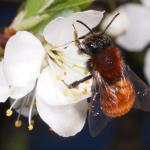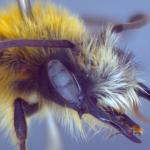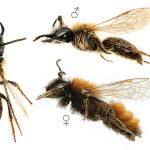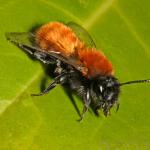Andrena armata (Gmelin, 1790), A. fulva (Schrank, 1781), A. tetrica (Harris, 1776), A. vestita (Fabricius, 1793), A. vulpina (Christ, 1791).
The female of this mining bee is one of the few Andrena species which can be instantly recognised in the field as it is clothed dorsally with long, dense, bright reddish hairs. For this reason it is frequently observed by householders when it excavates its nesting burrows in garden lawns. The male, however, is more sombre, being clad in sparser reddish-brown hairs, thereby resembling the males of many other species in the genus.
Throughout much of lowland England and Wales, and recently recorded in Scotland for the first time. In Ireland, known only from two sites in Kilkenny (Stelfox, 1927). It is also found in the Channel Islands (Richards, 1979). Widely distributed throughout much of Europe, eastwards to Bulgaria and Romania.
This species is not regarded as being scarce or threatened in Britain, although in Ireland it is listed as Regionally Extinct (RDB0 RE) (Fitzpatrick et al., 2006)
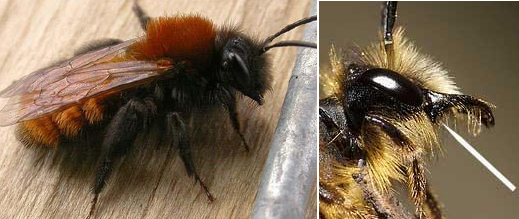
The female (above left) is one of our most distinctive mining bees. Fresh specimens, which appear early in the spring, have dense tawny red hairs covering the dorsal surface of the thorax and abdomen, contrasting with black hairs over the rest of the body and head.
Similar species: Osmia bicornis (O. rufa) is extensively covered with orange hairs and inexperienced students may confuse the two species. O. bicornis, has two horns on its face and a dense pollen scopa on the underside of its abdomen, unlike A. fulva. (Photo: Nigel Jones)
The male (above right) has a large tooth at the base of the mandible (arrowed). This is a feature shared with some other species, so look also for reddish-brown hairs on the thorax of fresh specimens (in fresh specimens these can appear relatively brightly coloured), plus long white hairs on the face (clypeus). For experienced aculeate students these three features together are fairly reliable for helping to determine male A. fulva. Inexperienced students should limit identifications to the much more distinctive female described below. (Photo: Nico Vereecken)
Similar species: Other male Andrena species that share the tooth at the base of the mandible are: A. apicata, A. praecox, A. fucata, A. lapponica and A. helvola.
Predominantly open grasslands, including chalk downland, pastures, parks and private gardens; occasionally open woodland.
Univoltine; late March to mid June.
Nests usually occur in aggregations which persist for many years. Most of these are established on level soil, preferably with short, sparse vegetation. One extensive aggregation was found in the side of a deep cart rut along a downland path in West Sussex (pers. obs.). The excavated soil forms a conspicuous tumulus in the centre of which is the nest entrance. Lateral burrows radiate away from the shaft of the main burrow at various intervals, each of these terminating in a single cell (see illustrations in O’Toole & Raw, 1991; Paxton & Pohl, 1999). A nest generally contains four or five cells, and a female can build two or three nests (O’Toole & Raw, 1991).
A wide range of herbs, shrubs and trees (see above for examples).
Nomada panzeri Lepeletier and N. signata Jurine are cleptoparasites of this bee (Perkins, 1919; Yarrow, 1941; Spooner, 1946; Guichard & Yarrow, 1948; Chambers, 1949; Westrich, 1989; Paxton & Pohl, 1999). In a site in south Wales, N. panzeri accounted for 18% cleptoparasitism of A. fulva (i.e. 18% of the host’s offspring were replaced by N. panzeri offspring) (Paxton & Pohl, 1999). Other inquilines encountered in the nests at this site were the bee-fly Bombylius major Linnaeus, the anthomyiid fly Leucophora obtusa (Zetterstedt) and three mermithid nematodes (one in each of three female bees). In some sites the species is stylopized by Stylops melittae Kirby.
2005
Identification section added 2011 by Nigel Jones


